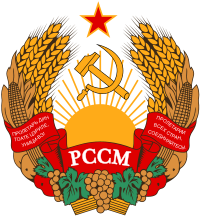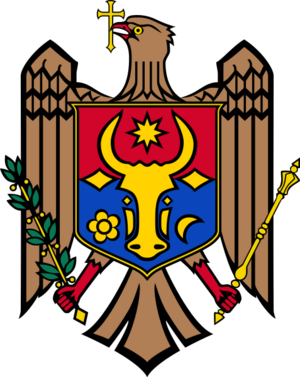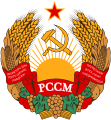Emblem of the Moldavian Soviet Socialist Republic facts for kids
Quick facts for kids Emblem of the Moldavian Soviet Socialist Republic |
|
|---|---|
 |
|
| Armiger | Moldavian Soviet Socialist Republic |
| Adopted | 10 February 1941 |
| Crest | Red star |
| Blazon | Rising sun with hammer and sickle |
| Supporters | Wheat, corn, grape and fruit |
| Motto | "Workers of the world, unite!" Пролетарь дин тоате цэриле, уници-вэ! (Romanian in Moldovan Cyrillic) Пролетарии всех стран, соединяйтесь! (Russian) |
The coat of arms of the Moldavian Soviet Socialist Republic was the official symbol of the Moldavian Soviet Socialist Republic (Moldavian SSR). This republic was part of the Soviet Union. The coat of arms was adopted on February 10, 1941.
It looked a lot like the main coat of arms of the Soviet Union. It featured symbols of agriculture, like wheat, corn, grapes, and clover. A red banner on the emblem showed the Soviet Union's motto: "Workers of the world, unite!" This motto was written in both Romanian (using the Moldovan Cyrillic alphabet) and Russian.
The letters "РССМ" were also on the emblem. These letters stood for "RSSM" in Romanian, which meant "Moldavian Soviet Socialist Republic." This emblem was used until November 3, 1990. After that, the country adopted the coat of arms of Moldova. Today, a region called Transnistria, which is not officially recognized by most countries, uses a very similar emblem.
Contents
History of the Emblem
How the Emblem Was Created
When the Moldavian SSR was formed on June 28, 1940, a temporary emblem was quickly made. This first emblem was similar to the one used by the Ukrainian SSR.
The official emblem was adopted on February 10, 1941. This happened when the first Supreme Council of the Moldavian SSR approved its Constitution. Article 122 of this Constitution described what the State Emblem should look like.
The emblem was designed by Eugen Nikitovich Merega. His work was recognized by the Communist Party. His design was used almost without changes until 1990.
Changes to the Emblem Over Time
In 1957, a small change was made to the spelling of the word "unite" in the Moldovan language (which was the name for Romanian in Moldova back then). The spelling was updated in the Cyrillic alphabet.
Later, in 1978, the Constitution of the Moldavian SSR was updated. Article 166 gave more details about the emblem's design.
In 1981, a painter named Alexei A. Colîbneac made some small improvements to the emblem's look. He changed how the colors and shadows were used. For example, black outlines became brown, and the sun's rays were made the same length.
These changes were officially mentioned in the "Regulations on the emblem of the republic" on May 7, 1981. This document described the colors of the emblem's parts, like the golden sickle and hammer, and the green leaves.
On November 3, 1990, a new coat of arms was adopted for Moldova. This new emblem was designed by Gheorghe Vrabie.
What the Emblem Meant
The symbols on the Moldavian SSR emblem had special meanings. These meanings were explained by officials in 1965 and 1981.
- The Red Star at the top meant it was a guiding star for everyone building communism.
- The Hammer and sickle showed the strong partnership between workers and farmers in the country.
- The rising sun symbolized the bright future of communism.
- The wreath of wheat ears, corn cobs, grape leaves, and fruit showed how fertile and rich the Moldavian Republic was. It meant the country was a thriving "orchard" of the Soviet Union.
- The motto "Workers of all countries, unite!" talked about the idea that people from all nations should work together. This showed the international spirit of the Moldavian people.
Another way to understand the emblem's symbols:
- The rising sun also represented a new era, the "communist era."
- The corn cobs and ears showed the republic's strong economy. They also meant there was plenty of food, like bread, vegetables, fruit, and grapes.
- The motto was like a "summoning bell" or a "torch." It lit the way for people to be free from oppression.
- The five-pointed star meant that the peaceful work of workers, farmers, and smart people was protected by the Soviet Army.
The "Regulations on the emblem of the republic" from 1981 also stated that the emblem was a symbol of the republic's independence. It also showed the strong bond between workers, farmers, and thinkers. It represented the friendship of all working people in the republic who were building communism.
Gallery

See also
 In Spanish: Escudo de la República Socialista Soviética de Moldavia para niños
In Spanish: Escudo de la República Socialista Soviética de Moldavia para niños





